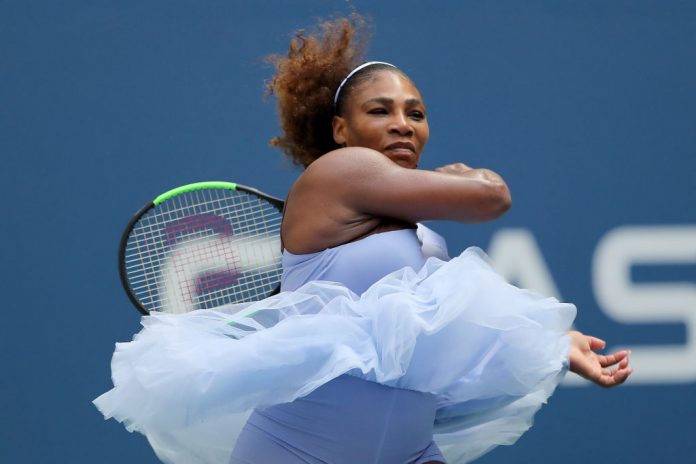Bill Simons
New York
You could say that Serena Williams transformed the sport of tennis.
But who’s kidding whom? She took a traditional game by the scruff of its neck and, despite all the screaming and yelling, turned it upside down and inside out. For a long while, tennis didn’t know what hit it.
“Bop!” “Bam!” “Wham!” What was going on here?
“Serena’s talent,” Elizabeth Weil noted, “is so singular that it feels as if it dropped whole from the heavens, a dense, crystalline meteorite of athletic prowess and drive.”
As mighty as Serena’s serve and forehands were, as devastating as her volleys were, as swift as her movement was, what really imposed was her will.
We all know her greatest hits. At 17, she won the US Open. At 19, she defied a roaring Indian Wells crowd to win the title. Twice she won the Serena Slam, claiming four Slams in a row. She claimed five Olympic gold medals. In 2015 she told a US lineswoman, “I’m going to shove this ball down your f–king throat!”
She became the oldest No. 1 player ever and won the 2017 Australian Open while two months pregnant. In 2018 she let it all out, in the most tumultuous and furious final in tennis history. Seven times she’s tried to equal Margaret Court’s record of 24 Slam wins. That she will likely fall short hardly matters.
What has long mattered on WTA courts is that for decades Serena’s warrior cry, “C’mon!” was the most dreaded sound in the game. “Never underestimate the power of a Williams” has long been a tennis mantra.
Many have said that Serena transcends tennis. But that’s far too timid. With her extraordinary skills, her resilience, her love of family, her celebration of motherhood, her “I’m going to do it my way” will, the visionary became a fashion-loving, risk-taking, red carpet and royal wedding celebrity in the class of Michelle Obama, Oprah and Beyoncé. She’s inspired millions.
But Williams just told us in a fashion magazine that she’s “evolving away from tennis.” Thanks to Serena and her sister, our core ideas about athletes have evolved dramatically.
For centuries, women tennis players had to be proper, slim, well-mannered competitors wearing acceptable gear: “Oh, dear, please don’t display improper undergarments, and, my goodness, dear, braids and beads are not part of our look.”
Over the decades, small handfuls of African-Americans became sports heroes. Joe Louis, Jesse Owens, Jackie Robinson, Althea Gibson and Arthur Ashe, among others, scored triumphs and broke barriers.
But all the while, to be accepted, they were careful, contained, measured. Certainly they had to be dignified competitors who subdued their rage at all cost.
On rare occasions, a few dared to go beyond. A century ago, boxer Jack Johnson wore furs and dated and married white women. It didn’t work. He went to prison on charges of immorality. Sprinters Tommie Smith and John Carlos lifted their fists on the podium at the 1968 Mexico City Olympics. The duo was kicked out of the games.
Muhammad Ali said he wouldn’t join the army to fight in Vietnam. He was promptly stripped of his title and almost went to jail – before he became a beloved international icon. Colin Kaepernick’s audacity derailed his career. And, for her part, Billie Jean King’s courageous breakthroughs cost her millions.
But Serena, who grew up just 11 miles north of Long Beach where King was reared, has long been unique. Bold defiance, bountiful self-worth and self-celebration are at the core of Serena’s stardom. Novelist Claudine Rankin noted, “Serena gives us the whole range of what it is to be human.” But it’s even more. With an uncanny ease and confidence, Williams has burst so many bubbles. For decades, her message has been, “I’m Serena! Hear me roar!” Writer Devon Friedman noted, “The Williams didn’t try to change the country club set: they simply bypassed them…They’re intimidating the way 13-year-old girls are to 13-year-old boys – they’re taller and better looking, and you get the idea that they could beat you up if they weren’t so disinterested in your existence.”
The GOAT, who’s won 73 titles and has altered our world in so many ways, comes into press conferences wearing a t-shirt that informs us of her mission. It reads: “Be a Game Changer.”
And she has changed so much. After Serena endured four bad calls at the 2004 US Open, electronic scoring was promptly implemented. After she wore a bodysuit in Paris, the French Open banned them. But then the WTA created a rule allowing them. After Serena was off the tour for 20 months, her ranking plummeted. The WTA soon passed rules to provide for pregnancy leaves.
And then there’s “the Williams effect.” Yes, Tiger Woods blasted his way to the top of the PGA, but virtually no other African-Americans followed. Naomi Osaka, Sloane Stephens, Coco Gauff and Madison Keys are just a few of the women of color who have emerged in the wake of Serena and her sister. Almost 20 of the WTA’s top 100 players are women of color.
In America, Serena has thrived in every cultural lane. There she is in Sports illustrated’s swimsuit issue. It can’t be a Super Bowl without a slew of Wonder Woman ads. What other No. 1 has had such deep connections to her family and has so celebrated motherhood? Often Serena seems to be more of an entrepreneur who creates fashion lines and strolls in lavish gowns or sports provocative biker suits, or a venture capitalist who raised $111 million. She’s rarely seen a magazine cover she wouldn’t like to be on.
Serena does not hold back. Say what you will, this woman has taught us that you don’t have to come from a country club to prevail; that you can boycott an event where you were booed as a teen; that you can come back from wretched first-round losses, from a traumatic childbirth and from not one but two brushes with death, that you can win a Slam with a baby in your belly, give birth, and then become a 33-time Slam finalist.
Serena has taught us that sisterhood is powerful, fashion is important, it’s wonderful to be a warrior queen and mothers can be badasses. She’s shown us that it’s fine to wear a daring bodysuit, it’s important to combat body shaming and it’s wonderful to celebrate a big, broad-shouldered woman. That it’s OK to marry a man of another race and call for racial justice in our legal system; that it’s OK to stand up for a quarterback who kneels and it is critical to diffuse the hostility of an angry crowd and the jabs of critics.
And, yes, she’s an international icon, too. Africans celebrate her school initiatives there and her investments in African start-ups. The head of Kenyan tennis, Mbugua Karani, recently noted, “Serena has been the ‘be-all’ for African tennis, and especially for girls in Africa…I can assure you there is nobody you ask, who is their greatest player, who’s a girl in Africa, that would not say, ‘Serena.’”
Italians take pride that Serena met her husband Alexis in a Roman cafe. The French note that Serena speaks their language, has an apartment in Paris and was long coached by a Frenchman, Patrick Mouratoglou.
In Britain, where Serena has won seven Wimbledons, she stole the show from Queen Elizabeth herself at Harry and Meghan’s royal wedding.
But, in her rebellious, free-form way, Serena is a quintessential American trailblazer. So it’s only appropriate that tennis’s biggest, splashiest and noisiest icon will be ending her star-spangled career on the 25th anniversary of the world’s biggest, splashiest and noisiest court, Arthur Ashe stadium, named after the most memorable African-American hero in men’s tennis.



















